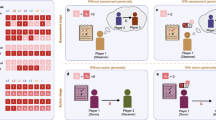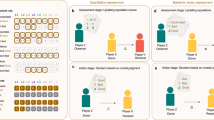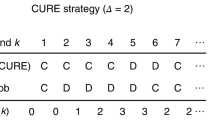Abstract
Indirect reciprocity is the most elaborate and cognitively demanding1 of all known cooperation mechanisms2, and is the most specifically human1,3 because it involves reputation and status. By helping someone, individuals may increase their reputation, which may change the predisposition of others to help them in future. The revision of an individual’s reputation depends on the social norms that establish what characterizes a good or bad action and thus provide a basis for morality3. Norms based on indirect reciprocity are often sufficiently complex that an individual’s ability to follow subjective rules becomes important4,5,6, even in models that disregard the past reputations of individuals, and reduce reputations to either ‘good’ or ‘bad’ and actions to binary decisions7,8. Here we include past reputations in such a model and identify the key pattern in the associated norms that promotes cooperation. Of the norms that comply with this pattern, the one that leads to maximal cooperation (greater than 90 per cent) with minimum complexity does not discriminate on the basis of past reputation; the relative performance of this norm is particularly evident when we consider a ‘complexity cost’ in the decision process. This combination of high cooperation and low complexity suggests that simple moral principles can elicit cooperation even in complex environments.
This is a preview of subscription content, access via your institution
Access options
Access Nature and 54 other Nature Portfolio journals
Get Nature+, our best-value online-access subscription
$29.99 / 30 days
cancel any time
Subscribe to this journal
Receive 51 print issues and online access
$199.00 per year
only $3.90 per issue
Buy this article
- Purchase on Springer Link
- Instant access to full article PDF
Prices may be subject to local taxes which are calculated during checkout




Similar content being viewed by others
References
Nowak, M. A. & Sigmund, K. Evolution of indirect reciprocity. Nature 437, 1291–1298 (2005)
Rand, D. G. & Nowak, M. A. Human cooperation. Trends Cogn. Sci. 17, 413–425 (2013)
Alexander, R. D. The Biology of Moral Systems (Transaction Publishers, 1987)
Feldman, J. Minimization of Boolean complexity in human concept learning. Nature 407, 630–633 (2000)
Chater, N. & Vitányi, P. Simplicity: a unifying principle in cognitive science? Trends Cogn. Sci. 7, 19–22 (2003)
Feldman, J. The simplicity principle in perception and cognition. Wiley Interdiscip. Rev. Cogn. Sci. 7, 330–340 (2016)
Ohtsuki, H. & Iwasa, Y. How should we define goodness?—reputation dynamics in indirect reciprocity. J. Theor. Biol. 231, 107–120 (2004)
Ohtsuki, H. & Iwasa, Y. The leading eight: social norms that can maintain cooperation by indirect reciprocity. J. Theor. Biol. 239, 435–444 (2006)
Brandt, H. & Sigmund, K. The logic of reprobation: assessment and action rules for indirect reciprocation. J. Theor. Biol. 231, 475–486 (2004)
Nowak, M. A. & Sigmund, K. Evolution of indirect reciprocity by image scoring. Nature 393, 573–577 (1998)
Ohtsuki, H., Iwasa, Y. & Nowak, M. A. Indirect reciprocity provides only a narrow margin of efficiency for costly punishment. Nature 457, 79–82 (2009)
Dunbar, R. Grooming, Gossip, and the Evolution of Language (Harvard Univ. Press, 1998)
Sommerfeld, R. D., Krambeck, H.-J., Semmann, D. & Milinski, M. Gossip as an alternative for direct observation in games of indirect reciprocity. Proc. Natl Acad. Sci. USA 104, 17435–17440 (2007)
Skyrms, B. Signals: Evolution, Learning and Information (Oxford Univ. Press, 2010)
Kandori, M. Social norms and community enforcement. Rev. Econ. Stud. 59, 63–80 (1992)
Stewart, A. J., Parsons, T. L. & Plotkin, J. B. Evolutionary consequences of behavioral diversity. Proc. Natl Acad. Sci. USA 113, E7003–E7009 (2016)
Wegener, I . & Teubner, B. The Complexity of Boolean Functions Vol. 1 (B. G. Teubner, 1987)
McCluskey, E. J. Minimization of Boolean functions. Bell Labs Tech. J. 35, 1417–1444 (1956)
Rendell, L. et al. Why copy others? Insights from the social learning strategies tournament. Science 328, 208–213 (2010)
Sigmund, K. The Calculus of Selfishness (Princeton Univ. Press, 2010)
Ohtsuki, H. & Iwasa, Y. Global analyses of evolutionary dynamics and exhaustive search for social norms that maintain cooperation by reputation. J. Theor. Biol. 244, 518–531 (2007)
Santos, F. P., Santos, F. C. & Pacheco, J. M. Social norms of cooperation in small-scale societies. PLOS Comput. Biol. 12, e1004709 (2016)
Pacheco, J. M., Santos, F. C. & Chalub, F. A. C. Stern-judging: a simple, successful norm which promotes cooperation under indirect reciprocity. PLOS Comput. Biol. 2, e178 (2006)
Hamlin, J. K. Moral judgment and action in preverbal infants and toddlers evidence for an innate moral core. Curr. Dir. Psychol. Sci. 22, 186–193 (2013)
Hamlin, J. K., Wynn, K., Bloom, P. & Mahajan, N. How infants and toddlers react to antisocial others. Proc. Natl Acad. Sci. USA 108, 19931–19936 (2011)
Resnick, P., Kuwabara, K., Zeckhauser, R. & Friedman, E. Reputation systems. Commun. ACM 43, 45–48 (2000)
Dellarocas, C. Reputation mechanism design in online trading environments with pure moral hazard. Inform. Syst. Res. 16, 209–230 (2005)
Ho, C.-J ., Zhang, Y ., Vaughan, J. & Van Der Schaar, M. Towards Social Norm Design for Crowdsourcing Markets. Report No. WS-12-08 (AAAI, 2012)
Zhang, Y. & van der Schaar, M. Peer-to-peer multimedia sharing based on social norms. Signal. Process. Image Commun. 27, 383–400 (2012)
Karnaugh, M. The map method for synthesis of combinational logic circuits. Trans. AIEE Part I 72, 593–599 (1953)
Fishman, M. A. Indirect reciprocity among imperfect individuals. J. Theor. Biol. 225, 285–292 (2003)
Roberts, G. Evolution of direct and indirect reciprocity. Proc. R. Soc. Lond. B 275, 173–179 (2008)
Sherratt, T. N. & Roberts, G. The importance of phenotypic defectors in stabilizing reciprocal altruism. Behav. Ecol. 12, 313–317 (2001)
Umans, C. The minimum equivalent DNF problem and shortest implicants. J. Comput. Syst. Sci. 63, 597–611 (2001)
Vigo, R. A note on the complexity of Boolean concepts. J. Math. Psychol. 50, 501–510 (2006)
Feldman, J. The simplicity principle in human concept learning. Curr. Dir. Psychol. Sci. 12, 227–232 (2003)
Null, L. & Lobur, J. The Essentials of Computer Organization and Architecture Ch. 3 (Jones & Bartlett Publishers, 2014)
Santos, F. P., Pacheco, J. M. & Santos, F. C. Evolution of cooperation under indirect reciprocity and arbitrary exploration rates. Sci. Rep. 6, 37517 (2016)
Stewart, A. J. & Plotkin, J. B. From extortion to generosity, evolution in the iterated prisoner’s dilemma. Proc. Natl Acad. Sci. USA 110, 15348–15353 (2013)
Stewart, A. J. & Plotkin, J. B. Collapse of cooperation in evolving games. Proc. Natl Acad. Sci. USA 111, 17558–17563 (2014)
Pinheiro, F. L., Vasconcelos, V. V., Santos, F. C. & Pacheco, J. M. Evolution of all-or-none strategies in repeated public goods dilemmas. PLOS Comput. Biol. 10, e1003945 (2014)
Hilbe, C., Martinez-Vaquero, L. A., Chatterjee, K. & Nowak, M. A. Memory-n strategies of direct reciprocity. Proc. Natl Acad. Sci. USA 114, 4715–4720 (2017)
Traulsen, A., Nowak, M. A. & Pacheco, J. M. Stochastic dynamics of invasion and fixation. Phys. Rev. E 74, 011909 (2006)
Acknowledgements
This work was supported by Fundação para a Ciência e Tecnologia (FCT) through grants SFRH/BD/94736/2013, PTDC/EEI-SII/5081/2014, PTDC/MAT/STA/3358/2014, UID/BIA/04050/2013 and UID/CEC/50021/2013. We are grateful to A. P. Francisco and M. Janota for comments.
Author information
Authors and Affiliations
Contributions
F.P.S., F.C.S. and J.M.P. conceived the project. F.P.S. performed the mathematical and numerical analysis. F.P.S., F.C.S. and J.M.P. analysed the results and wrote the paper. All authors contributed to all other aspects of the project.
Corresponding author
Ethics declarations
Competing interests
The authors declare no competing financial interests.
Additional information
Reviewer Information Nature thanks C. Efferson, E. Fehr, G. Szabó and A. Tavoni for their contribution to the peer review of this work.
Publisher's note: Springer Nature remains neutral with regard to jurisdictional claims in published maps and institutional affiliations.
Extended data figures and tables
Extended Data Figure 1 Cooperation index of third- and fourth-order norms.
In the space of fourth-order norms (red bars), only a small fraction of norms (about 0.2% of 216) foster high levels of cooperation (η > 0.9), as conveyed by the complementary cumulative distribution function (CCDF; see inset for a close-up of the tail). In the space of third-order norms (blue bars), about 2% of norms (of a total of 28) promote high levels of cooperation (η > 0.9). Other parameters: Z = 50, ε = α = χ = 0.01, μ = 1/Z, b = 5, c = 1, γ = 0.
Extended Data Figure 2 The most cooperative norms.
a, c, e, g, Data from simulations in which individuals pay a complexity cost cc proportional to the complexity κs of the strategy that they employ (cc = cκs/10 = γκs). b, d, f, h, Data when no complexity cost is involved. Irrespective of whether the previous reputation of the recipient (a–d) or the donor (e–h) is used as the fourth consideration (as the fourth-order bit; see Extended Data Fig. 3), or whether there is a complexity cost involved, the highest levels of cooperation are already achieved for κ = 4. Moreover, when we plot norm performance (in terms of the cooperation index), separating norms according to their complexity κ (for κ ≤ 5; c, d, g and h) it becomes apparent that fourth-order norms are generally outperformed by lower order norms. Furthermore, paying a complexity cost is most detrimental to the more sophisticated fourth-order norms, which no longer promote cooperation under indirect reciprocity. Other parameters: Z = 50, ε = α = χ = 0.01, μ = 1/Z, b = 5, c = 1.
Extended Data Figure 3 Alternative ways of defining a social norm.
a, b, We consider norms that attribute a new reputation (outer ring) on the basis of (i) the action of the donor (first-order bit; blue ring); (ii) the current (actual) reputation of the receiver (second-order bit; yellow ring); (iii) the current (actual) reputation of the donor (third-order bit; pink ring); and (iv) the previous reputation of either the recipient (a) or the donor (b) (fourth-order bit; green ring). In a and b, there are 216 norms in total. c, Number of bits (layers, l) used for each norm order, and the corresponding number of possible strategies (s) and norms. Because actions are taken using the same information used by a norm to attribute a new reputation, we consider 28 different strategies for norms up to fourth-order.
Extended Data Figure 4 Robustness of results to parameter variations.
A full list and detailed description of all model parameters is provided in Supplementary Information. a–d, Norm performance (in terms of the complexity index) as a function of population size Z (a), the benefit-to-cost ratio b/c in the donation game in which individuals interact (b), the private assessment error probability χ (c) and the reputation assignment probability τ (d). Here we use the previous reputation of the recipient as the fourth-order bit (as in the main text) and investigate, within the space of fourth-order norms, the performance of the (second- and third-order) leading eight norms together with the (first-order) image score and (zeroth-order) all good norms. The norms ‘ss’ and ‘sj’ denote simple standing and stern judging; ‘ss + sj’ has the first 8 bits equal to the third-order representation of simple standing and the last 8 equal to the third-order representation of stern judging; and ‘sj + ss’ is defined similarly; see Supplementary Table 4 for details of these norms. Other parameters: Z = 50, ε = α = χ = 0.01, μ = 1/Z, b = 5, c = 1, γ = 0.
Extended Data Figure 5 Global versus local mutation schemes.
b, We consider a mutation scheme in which a new strategy is adopted with probability μ (drawn from a UPD) when a mutation occurs39,40,41,42. c, Alternatively, we consider a local mutation (in each strategy), whereby with probability μL (drawn from a UPD) one bit changes. a, For the leading eight norms8, we find that the same conclusions are attained regardless of the mutation scheme considered. Other parameters: Z = 50, ε = α = χ = 0.01, b = 5, c = 1, γ = 0.
Extended Data Figure 6 Pseudo code for the Monte Carlo simulations used to calculate the cooperation index under each norm.
Given the large number of norms considered, we used Runs = 15 and Gens = 1.5 × 104 in Figs 2, 3, 4 and Extended Data Figs 1 and 2, and Runs = 50 and Gens = 105 in Extended Data Figs 4 and 5.
Supplementary information
Supplementary Information
This file contains a Supplementary Discussion, Supplementary Tables 1-4 and Supplementary References. (PDF 345 kb)
Rights and permissions
About this article
Cite this article
Santos, F., Santos, F. & Pacheco, J. Social norm complexity and past reputations in the evolution of cooperation. Nature 555, 242–245 (2018). https://doi.org/10.1038/nature25763
Received:
Accepted:
Published:
Issue Date:
DOI: https://doi.org/10.1038/nature25763
This article is cited by
-
Dynamics of collective cooperation under personalised strategy updates
Nature Communications (2024)
-
Effect of reciprocity mechanisms on evolutionary dynamics in feedback-evolving games
Nonlinear Dynamics (2024)
-
Quantitative assessment can stabilize indirect reciprocity under imperfect information
Nature Communications (2023)
-
Evolution of cooperation in multiplex networks through asymmetry between interaction and replacement
Scientific Reports (2023)
-
Complexity of Behavioural Strategies and Cooperation in the Optional Public Goods Game
Dynamic Games and Applications (2023)
Comments
By submitting a comment you agree to abide by our Terms and Community Guidelines. If you find something abusive or that does not comply with our terms or guidelines please flag it as inappropriate.



